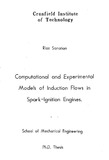JavaScript is disabled for your browser. Some features of this site may not work without it.
| dc.contributor.advisor | Moss, J. B. | |
| dc.contributor.author | Sanatian, R. | |
| dc.date.accessioned | 2010-01-19T12:05:50Z | |
| dc.date.available | 2010-01-19T12:05:50Z | |
| dc.date.issued | 1988-03 | |
| dc.identifier.uri | http://hdl.handle.net/1826/4155 | |
| dc.description.abstract | The objective of this thesis is to combine computational flow modelling, flow visualization and point measurements of mean flow and turbulence properties to obtain a better, more detailed, understandýing of the effects of alternative throttling devices on mixture preparation and turbulence generation in spark ignition engines. In so doing, it also seeks to assess the wider diagnostic potential of flow field computational techniques in internal combustion engine designs. Full-scale models, comprising simplified representations of the induction tract, throttling device, inlet valve and cylinder, have been manufactured in Perspex for steady-state water analogy tests. The resulting photographs of flow tracers in a variety of viewing planes provide a clear, but qualitative, picture of the princi - pal features of the flow in the models under study. The essentially qualitative data obtained from water analogy tests are complemented by limited hot wire velocity measurements at particular stations in the Perspex models, with air replacing the water as the flow medium. These data, supplemented by information in the literature, provide the framework for comparisons with an extensive computational simulation of induction flows which are performed using the general purpose PHOENICS code developed by CHAM. These studies include both transient and steady state predictions. The statistically stationary turbulent flow field through alternative induction system throttling devices -a conventional butterfly valve and a variable geometry ramp restriction- are modelled computationally and compared with water analogy flow visualization. The principal flow field characteristics are satisfactorily reproduced, including in particular the extent of the recirculation zone in the lee of the throttle and the relative persistence of the turbulence generated downstream for varying throat apertures. That generated by the two-dimensional variable geometry ramp is predicted to be both higher and persist beyond the inlet valve into the cylinder producing discernible swirl at high throttle settings. The limited quantitative comparisons with hot wire velocity measurements lend further support to the more detailed aspects of the computational predictions. Finally, comparisons are made between PHOENICS predictions and Laser-Doppler measurements of velocity for transient flow inside an axisymmetric motored piston-cylinder assembly, for different valve seat angles, reported in the literature. The agreement is again very encouraging, reinforcing the view that general purpose computer codes of the kind investigated can play an important role in detailed design assessment and evaluation. | en_UK |
| dc.language.iso | en | en_UK |
| dc.publisher | Cranfield University | en_UK |
| dc.title | Computational and experimental models of induction flows in spark-ignition engines | en_UK |
| dc.type | Thesis or dissertation | en_UK |
| dc.type.qualificationlevel | Doctoral | en_UK |
| dc.type.qualificationname | PhD | en_UK |
